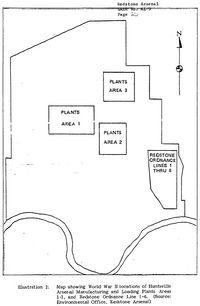Redstone Arsenal
|
Redstone Arsenal (1941-Present) - A U.S. Army arsenal established in 1941 during World War II in present-day Huntsville, Madison County, Alabama. The Arsenal made conventional ammunition and toxic chemicals during World War II. The Arsenal became the center of U.S. Army rocket and missile programs postwar. Active military installation.
History Established as a 38,658 acre U.S. Army Arsenal in 1941. Made conventional ammunition and toxic chemicals during World War II. The Huntsville Arsenal and Huntsville Depot were combined into the Redstone Arsenal on 30 Jun 1949 with Redstone Arsenal assuming the command functions. NASARedstone Arsenal became the center of U.S. Army rocket and missile programs post WWII. Six months after Explorer I, on 29 Jul 1958, President Dwight Eisenhower created the National Aeronautics and Space Administration (NASA) and he approved the transfer of all Army space-related activities to NASA. On 1 Jul 1960, 4,670 civilian employees, about $100 million worth of buildings and equipment, and some 840 acres of land were transferred from the Redstone Arsenal ABMA Development Operations Division to NASA's new George C. Marshall Space Flight Center (MSFC), now a tenant on Redstone Arsenal. Werner Von Braun, the famed German rocket scientist, was named the first director of the Marshall Space Flight Center and became the chief architect of the Saturn V launch vehicle, the booster rocket that sent Americans to the Moon. The current director (2021) is Jody Singer.
Army Missile CommandThe U.S. Army Missile Command (MICOM) was activated on 1 August 1962 at Redstone Arsenal. Project Nike anti-aircraft missiles had been developed by them and partially deployed but as ICBMs came into existence with ever-increasing range, a much higher-performance system became necessary for ICBM defense. The Advanced Research Projects Agency (ARPA) examined the requirements and recommended a system, designated Nike-X, incorporating phased-array radars, high-performance computers, and separate low-altitude (Sprint) and high-altitude (Spartan) high-velocity interceptor missiles. To manage this development, in 1963 MICOM created the Nike-X Project Office. ABM system requirements were revised and the Sentinel System replaced the Nike-X. In 1968, the Army Ballistic Missile Defence Agency (ABMDA) was formed, taking over Sentinel and other ballistic missile defense projects previously under MICOM. ABMDA established operations adjacent to Redstone Arsenal in the Cummings Research Park. In May 1974, all ballistic missile defense efforts were consolidated under a single manager in the Ballistic Missile Defense Organization, which eventually evolved into today's U.S. Army Space and Missile Defense Command. On 17 Jul 1997, the former Army Missile Command combined with the aviation portion of the U.S. Army Aviation and Troop Command (ATCOM), creating a new organization at Redstone Arsenal, the U.S. Army Aviation and Missile Command (AMCOM). Current OperationsRedstone Arsenal is the center of testing, development, and doctrine for the Army's missile programs. It currently houses the U.S. Army Materiel Command and the U.S. Army Aviation and Missile Life Cycle Management Command, Redstone houses the Tactical UAV Project Office, Redstone Test Center (RTC), the Missile Defense Agency, the Missile, and Space Intelligence Center, and other missile and space operations. Redstone Arsenal continues to host the Marshall Space Flight Center, NASA's field center for propulsion analysis and development. On 13 Jan 2021, it was announced that Redstone Arsenal is the preferred location for the headquarters of the United States Space Command. The base workforce is predominately civilian employees and averages 36,000 to 40,000 military and civilian personnel daily. Current StatusActive military installation, Redstone Arsenal, Huntsville,
Sources:
Visited: 31 Jul 2021
| |||||||
